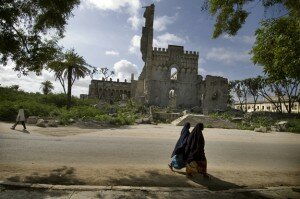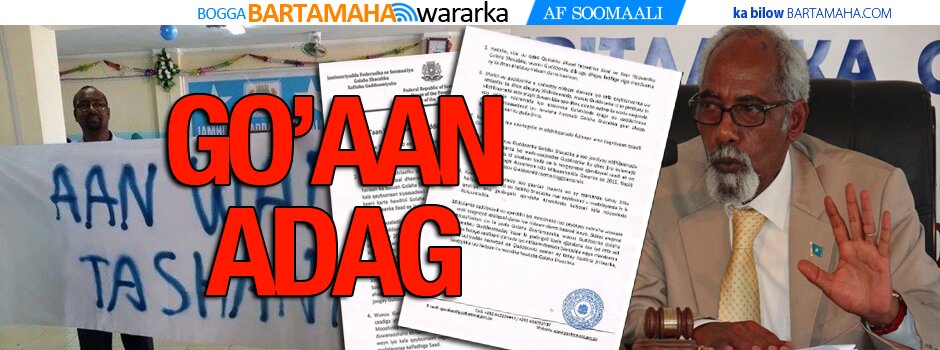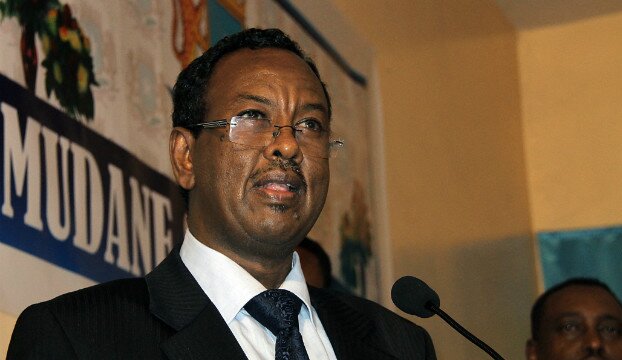In the Beginning, There Was Somalia

Bartamaha (Nairobi):-In the waning days of his presidency, with very little planning or even forethought, George H.W. Bush sent 28,000 U.S. troops to support a humanitarian mission in a hapless country of no strategic significance to the United States. That noble endeavor ended, of course, with the fiasco known as Black Hawk Down. Somalia was scarcely history’s first failed state, but it was the first one whose failure U.S. policy sought consciously to address. Today, three U.S. administrations, two U.N. secretaries-general, and 18 years later, Somalia has a raging Islamist insurgency, a government that controls a few city blocks, and African Union peacekeepers with no peace to keep. And once again this year, Somalia stands atop the Foreign Policy/Fund for Peace Failed States Index — a testament to the persistence of state pathology and the weakness of the powers the world community can bring to bear.
Barack Obama came into office acutely, perhaps uniquely, aware of the problem of failed states, but his administration has yet to develop an explicit policy on the subject, let alone increase the U.S. government’s capacity to heal these profoundly sick patients. Obama has an intuitive grasp of the transnational problems of the post-Cold War world — nuclear proliferation, global warming, pandemic disease. The same is true of failing states. In an August 2007 speech, during the first months of his presidential campaign, Obama asserted that the “nearly 60 countries” that “cannot control their borders or territory, or meet the basic needs of their people” constituted not only a moral dilemma but also a security challenge to the West. Candidate Obama vowed to “roll back the tide of hopelessness that gives rise to hate” by helping failed states establish good governance and the rule of law, doubling foreign assistance to attack entrenched poverty, establishing a $2 billion education fund “to counter the radical madrasas … that have filled young minds with messages of hate,” and opening “America Houses” across the Islamic world.
The premise that the 9/11 terrorist attacks had made weak states not just a moral problem but a matter of national security was scarcely new; it was a central axiom of President George W. Bush’s foreign policy after the attacks (and even President Bill Clinton, in the pre-9/11 era, had seen failing states as a threat to the emerging, democratic, free market world order). But Obama’s emphasis on economic and social development was very different from the bellicosity of regime change and the grandiose hopes of Bush’s Freedom Agenda. As president, Obama has indeed sought more funding for development assistance, though the economic crisis and ballooning budget deficit have made Congress wary of authorizing his aid budgets and the conflicts in Afghanistan and Iraq have absorbed much of his attention. Most of his other promises remain on the drawing board — if they’re anywhere.
At the most basic intellectual level, there is an unacknowledged tension in the Obama administration’s thinking about this issue. Obama has persistently argued that addressing the poverty and misery of people in remote places is a U.S. national interest. But the case he has made is, like Bush’s, limited to the threat of terrorism and does not have much to say about, for example, the threat that collapsing states pose to more stable neighbors. And that’s true of others in the administration as well. In the May/June issue of Foreign Affairs, Defense Secretary Robert Gates argues that because terrorist attacks are most likely to emanate from weak states, “Dealing with such fractured or failing states is, in many ways, the main security challenge of our time.” Where, however, does that leave the Democratic Republic of the Congo (No. 5 on FP’s list), or Ivory Coast (12), or Burma (16), whose doomed and despairing citizens are not likely to take up arms against the West?
If no explicit policy exists, an implicit one has begun to emerge. Anne-Marie Slaughter, director of policy planning at the State Department, told me that Afghanistan is “the petri dish” for the administration’s strategy on weak and failing states. And by that she means the Obama team’s embrace of a nation-building plan that puts development in a place equal to security. Development must be understood less as providing aid than as building government capacity. “That’s the shift,” she says. “There’s a big emphasis not just on delivering services, which happens through contractors and NGOs, but enabling the government to provide the services.“
There is an evident logic to seeing Afghanistan as the new template for U.S. policy toward failing states. Afghanistan is not only the most serious such problem this administration is facing but also the laboratory in which it has done by far the most experimenting. Afghanistan is also, of course, the one failed state into which the United States has poured a torrent of money, with authorized funds since the inception of the war totaling $300 billion. The United States is tripling the civilian head count in Afghanistan and just as importantly, dispersing civilians out of Kabul and into provincial and district capitals. The emphasis, Slaughter says, is very much on persuading ordinary Afghans that their government is worth defending. But Afghanistan makes for a very tough paradigm. Nation-building is almost impossible to do amid a raging insurgency, as the United States learned in Iraq. Doing so at warp speed, with a troop pullout looming, is yet harder.
Afghanistan is invariably one of those places where the tide of hopelessness gives rise to hatred. But Slaughter says that Haiti should also be seen as a model of administration policy. Slaughter says that in the aftermath of the country’s Jan. 12 earthquake, the Obama administration recognized that Haiti needed help with security and development — and that the investment in development had to bolster the country’s own capacity. And the United States must work with existing partners, especially the Brazilians, who have formed the core of the U.N. peacekeeping force there. In Haiti, as in Yemen, where the United States must work with neighbors (read: Saudi Arabia), other donors, and regional and multinational bodies, diplomacy is an indispensable element of the response to failed and fragile states. Indeed, Yemen, now seen as an incubator of terrorism, might well become the administration’s next petri dish.
So that’s the policy, at least in its current inchoate form. On this issue, as on others, Obama administration officials tend to brandish their intellectual bona fides in a bid for forbearance: They’ve thought hard about these questions. They care deeply about them. They’re getting to the right place. It’s still early days. All true — U.S. Ambassador to the United Nations Susan Rice, for instance, led a Brookings Institution project on failed states, and White House advisor Samantha Power literally wrote the book on genocide — but faith begins to wear thin. One senior figure at an NGO that deals with fragile states says, “I do think this group comes in with a much different vision of the issues at play, but I don’t see that there has been much of a change in policy that reflects the change in mindset.”
Fixing failed states requires not just a coherent plan, but very large commitments of money, people, and time. There must be boots on the ground — but who will fill them? When the White House decided on the civilian “uplift” in Afghanistan, as it is known, there was no pool of available civilian experts from which the State Department or the U.S. Agency for International Development (USAID) could draw. They just went out and started hiring people willing and able to go for a year and then slotted them into job openings.
There was supposed to be such a pool. In 2004, the Bush administration overcame its ideological disapproval of nation-building and agreed to establish the Office of the Coordinator for Reconstruction and Stabilization (S/CRS), housed at the State Department. The idea, as U.S. Institute of Peace expert Robert Perito recalls, was to create a single “command-and-control group” for the government, so the civilian response to a natural disaster or political crisis could be as rapid and effectively coordinated as the military one. It didn’t work out that way. S/CRS became a bureaucratic orphan; its first chief, Carlos Pascual, now the U.S. ambassador to Mexico, quit in disgust. The office got emergency funding from the Pentagon, but had no budget of its own until the 2008-2009 fiscal year. Its current director, John Herbst, operates largely at the whim of the department’s powerful regional bureau chiefs.
Despite its lower status on the org chart, S/CRS has now become operational. The office runs theCivilian Response Corps, which consists of an active force, ready to be dispatched abroad within 48 hours, and a standby force, employed elsewhere in the federal government and available to S/CRS for one year out of four. The office now has more than 100 of the former and about 800 of the latter, though its authorized strength is 260 and 2,000, respectively. Todd Calongne, the office’s spokesman, describes S/CRS as “the Special Forces of the civilian U.S. government.” In a warehouse in Springfield, Virginia, the office has established what Calongne calls “an embassy in a suitcase,” with satellite-linked communications equipment, armored vehicles, tents, and so on.
But the response corps is not ready for prime time. Herbst says that Richard Holbrooke asked to meet with him the day Holbrooke was sworn in as special representative for Afghanistan and Pakistan. “He wanted to know what we could do,” recalls Herbst, who had to explain that “we could not be a major part of staffing the operation.” The office just didn’t have the manpower. It did, however, draw up the plans that govern ties between civilians and the military in Afghanistan’s regional commands and on provincial reconstruction teams; Calongne says that it has sent to Afghanistan and Pakistan more than 75 experts in communications, planning, conflict assessment, and the rule of law. A member of Holbrooke’s team told me, “They’ve played a substantial role, but within the guidance and policy articulated by this office.” Officials speak of Sudan, which might split in half after a referendum next January, as the first crisis S/CRS will address from the outset. The office now has five officials in the country and four more working with special envoy Scott Gration in Washington.
Given its modest size and political position, S/CRS can constitute only one part of a potential response. The obvious candidate for properly taking responsibility is USAID. But the agency today, halved to just 8,000 staff members worldwide from its Vietnam War peak, does little beyond administer contracts carried out by private firms. Obama and Secretary of State Hillary Clinton, acknowledging the need for an operational civilian force, have vowed to revitalize the agency. USAID’s new administrator, Rajiv Shah, will be authorized to hire 1,000 new employees and might even get an occasional seat at National Security Council meetings. Still, the agency is widely viewed as a cautious and lumbering relic, ill-fitted to the turbulent world of failing states; USAID’s culture might take a lot longer to change than its structure. And, as Perito says, “It’s very hard to have a policy towards fragile states if you don’t have a development entity which functions.“
Failed states matter. That is perhaps the most decisive change since the first George Bush sent the Marines to Somalia or Bill Clinton agonized over acting in the Balkans, where, as former Secretary of State James Baker famously said, “We have no dog in that fight.” U.S. interests can no longer be extricated from those of faraway countries. But America’s stake in the well-being of Somalia does not make Somalia’s problems any easier to cure. The remarkable fixity of the Failed States Index stands as a reproach to America’s nonchalant faith in progress and its own capacity to solve the world’s woes. The Obama administration, which specializes in thinking hard about hard problems, is still a long way from getting its arms around this one.
————–
Source:- foreignpolicy.com
Comments
comments
 Calendar
Calendar





































